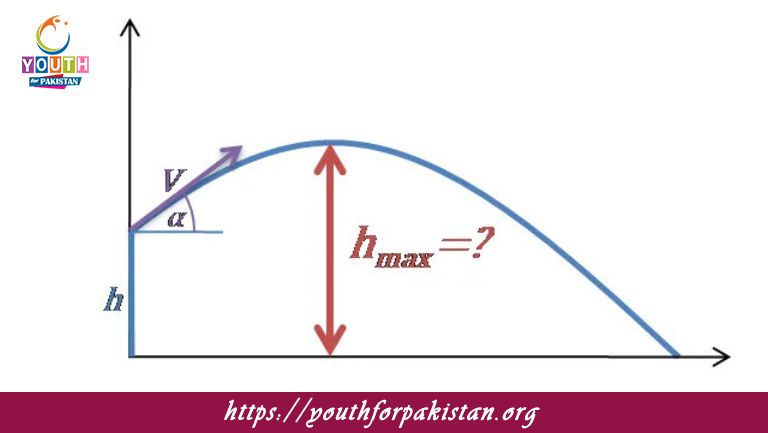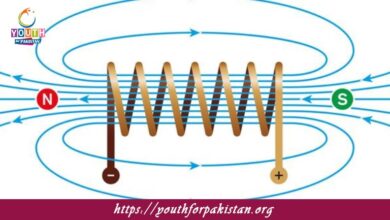Projectile Motion Maximum Height MDCAT MCQs with Answers

Welcome to the Projectile Motion Maximum Height MDCAT MCQs with Answers. In this post, we have shared Projectile Motion Maximum Height Multiple Choice Questions and Answers for PMC MDCAT 2024. Each question in MDCAT Physics offers a chance to enhance your knowledge regarding Projectile Motion Maximum Height MCQs in this MDCAT Online Test.
Projectile Motion Maximum Height MDCAT MCQs Test Preparations
The maximum height of a projectile is determined by:
a) Initial speed only
b) Angle of projection only
c) Both initial speed and angle of projection
d) Gravitational acceleration only
If a projectile is launched with an initial speed of 20 m/s at an angle of 30°, what is the maximum height reached?
a) 10 m
b) 5 m
c) 15 m
d) 20 m
For a projectile launched at 45° to the horizontal, the maximum height depends on:
a) Only the horizontal component of velocity
b) Only the vertical component of velocity
c) Both components of velocity equally
d) The time of flight
What is the maximum height of a projectile if its initial velocity is 30 m/s and the launch angle is 60°?
a) 45 m
b) 60 m
c) 75 m
d) 90 m
If the maximum height of a projectile is 20 m, what is the initial vertical velocity component?
a) 10 m/s
b) 14 m/s
c) 20 m/s
d) 28 m/s
A projectile is launched with an initial speed of 50 m/s at an angle of 60°. The maximum height achieved is:
a) 64.3 m
b) 75.0 m
c) 85.3 m
d) 100.0 m
What happens to the maximum height of a projectile if the angle of projection is increased from 30° to 45°, keeping the initial speed constant?
a) It increases
b) It decreases
c) It remains the same
d) It becomes zero
If a projectile reaches a maximum height of 40 m, the initial vertical component of its velocity is:
a) 28 m/s
b) 30 m/s
c) 40 m/s
d) 45 m/s
What is the effect of gravity on the maximum height of a projectile?
a) It has no effect
b) It decreases the maximum height
c) It increases the maximum height
d) It affects only the time of flight
The maximum height of a projectile launched at an angle of 90° to the horizontal is:
a) Zero
b) Equal to the initial speed
c) The maximum possible height for that speed
d) Half the initial speed
If the initial speed of a projectile is doubled while keeping the angle of projection constant, what happens to the maximum height?
a) It doubles
b) It quadruples
c) It remains the same
d) It halves
A projectile is launched at 60° with an initial velocity of 25 m/s. What is the maximum height?
a) 15.6 m
b) 18.6 m
c) 20.0 m
d) 23.4 m
If the maximum height of a projectile is 25 m, then the maximum vertical component of its velocity is:
a) 20 m/s
b) 25 m/s
c) 30 m/s
d) 35 m/s
The maximum height of a projectile depends on which of the following?
a) Initial speed and angle of projection
b) Initial speed only
c) Angle of projection only
d) Distance traveled
For a projectile with an initial speed of 40 m/s launched at 45°, the maximum height is:
a) 40 m
b) 60 m
c) 80 m
d) 100 m
If a projectile reaches a maximum height of 50 m, the time to reach this height is:
a) 5 s
b) 10 s
c) 15 s
d) 20 s
A projectile with an initial speed of 15 m/s reaches a maximum height of 11.25 m. What is the launch angle?
a) 30°
b) 45°
c) 60°
d) 75°
The maximum height of a projectile is achieved when the launch angle is:
a) 0°
b) 30°
c) 45°
d) 90°
If the initial speed of a projectile is 25 m/s and the maximum height is 31.25 m, the launch angle is:
a) 30°
b) 45°
c) 60°
d) 75°
What is the maximum height of a projectile if it is launched with an initial speed of 40 m/s at 30°?
a) 20 m
b) 30 m
c) 40 m
d) 50 m
The height attained by a projectile is independent of:
a) Initial speed
b) Launch angle
c) Horizontal velocity
d) Gravitational acceleration
A projectile is launched with an initial speed of 10 m/s at an angle of 30°. The maximum height is:
a) 2.5 m
b) 5.0 m
c) 7.5 m
d) 10.0 m
For a given initial speed, the maximum height of a projectile is highest when the launch angle is:
a) 30°
b) 45°
c) 60°
d) 90°
If a projectile reaches a maximum height of 16 m, what is the vertical component of its initial velocity?
a) 14 m/s
b) 16 m/s
c) 18 m/s
d) 20 m/s
The maximum height of a projectile launched at an angle of 45° with an initial speed of 50 m/s is:
a) 62.5 m
b) 75.0 m
c) 87.5 m
d) 100.0 m
What is the effect of increasing the initial velocity on the maximum height of a projectile?
a) The maximum height decreases
b) The maximum height increases
c) The maximum height remains unchanged
d) The effect is unpredictable
The height reached by a projectile is determined by:
a) Initial horizontal velocity
b) Initial vertical velocity
c) Both horizontal and vertical velocities
d) Initial kinetic energy
A projectile is launched with an initial speed of 25 m/s at an angle of 30°. The maximum height is:
a) 9.4 m
b) 12.5 m
c) 15.6 m
d) 18.4 m
What is the maximum height of a projectile launched at an angle of 75° with an initial speed of 20 m/s?
a) 13.3 m
b) 15.0 m
c) 17.0 m
d) 19.2 m
If a projectile reaches a maximum height of 22.5 m, the initial vertical component of velocity is:
a) 15 m/s
b) 18 m/s
c) 20 m/s
d) 25 m/s
The maximum height of a projectile is highest when launched at:
a) 30°
b) 45°
c) 60°
d) 75°
The maximum height of a projectile launched with an initial speed of 35 m/s and at an angle of 60° is:
a) 30 m
b) 35 m
c) 40 m
d) 45 m
A projectile launched at 45° with an initial speed of 10 m/s reaches a maximum height of:
a) 2.55 m
b) 3.20 m
c) 4.55 m
d) 5.10 m
The maximum height of a projectile is:
a) The distance traveled horizontally
b) The distance traveled vertically
c) The vertical displacement
d) The difference between the launch height and the maximum height
If the maximum height of a projectile is 12.25 m, the initial vertical component of its velocity is:
a) 10 m/s
b) 12 m/s
c) 14 m/s
d) 16 m/s
If you are interested to enhance your knowledge regarding Physics, Chemistry, Computer, and Biology please click on the link of each category, you will be redirected to dedicated website for each category.





